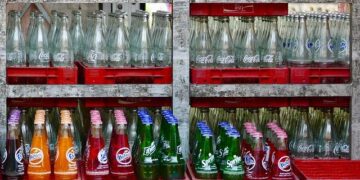Title: America’s Dependence on Chinese Minerals: Beijing’s Strategy to Maintain Control
In today’s deeply interconnected global marketplace, the reliance on critical resources has become a pivotal issue fueling geopolitical friction. While the United States strives to diversify its supply chains and lessen dependence on foreign entities, one crucial factor often escapes full attention: China’s overwhelming dominance in supplying essential minerals. From rare earth elements indispensable for cutting-edge electronics to lithium vital for powering electric vehicles, America increasingly depends on imports from China. Amid escalating trade disputes and efforts to boost domestic production, Beijing is determined to preserve its stronghold over these strategic materials—shaping not only U.S. manufacturing but also international commerce and diplomatic relations. This article delves into the complexities of America’s mineral dependency on China and examines the strategic responses emerging from this challenge.
National Security Risks Stemming from U.S. Reliance on Chinese Minerals
The United States’ growing dependence on minerals sourced predominantly from China poses significant national security concerns. Rare earth elements—critical components in everything from smartphones and medical devices to advanced defense systems—are largely controlled by Chinese suppliers who dominate global production with approximately 60% of output as of 2023. This concentration creates a potential chokepoint; any disruption due to political tensions or economic coercion could severely impact American technological capabilities.
As countries accelerate their transition toward green energy solutions such as wind turbines, solar panels, and electric vehicles (EVs), demand for these minerals is projected to surge dramatically over the next decade according to recent International Energy Agency forecasts. This intensifies vulnerabilities tied to supply chain dependencies.
To address these risks effectively, U.S policymakers must explore diversified strategies including:
- Expanding domestic mining initiatives: Unlocking untapped mineral reserves within U.S borders through responsible mining practices.
- Advancing recycling technologies: Enhancing methods that recover rare metals from electronic waste streams.
- Forging stronger alliances: Collaborating with trusted partners like Australia and Canada who possess abundant mineral deposits.
Complementary legislative support combined with increased funding for research can pave the way toward securing resilient supply chains that safeguard national interests while promoting economic stability.
Diversification Strategies: Reducing Dependence on China’s Mineral Supply Chains
Mitigating risks linked with reliance on Chinese mineral exports requires a comprehensive approach centered around diversification at multiple levels:
Boosting Domestic Production:
Investments aimed at expanding mining infrastructure domestically are crucial steps forward. The United States holds significant deposits of lithium in Nevada’s Clayton Valley and rare earth elements in states like California and Wyoming; however, regulatory hurdles have slowed development compared with China’s streamlined operations.
Cultivating International Partnerships:
Strengthening ties with resource-rich allies such as Australia—which accounts for roughly a quarter of global critical mineral output—and Canada offers alternative sourcing routes less vulnerable to geopolitical disruptions involving China.
Promoting Circular Economy Practices:
Developing efficient recycling programs targeting end-of-life electronics can reduce pressure on virgin material extraction while supporting sustainability goals aligned with climate commitments.
Pioneering Material Innovation:
Funding research into substitutes or synthetic alternatives capable of replacing scarce minerals could revolutionize technology manufacturing by reducing dependency altogether.
Through coordinated efforts across government agencies, private sector stakeholders, and international collaborators, America can build more secure frameworks ensuring steady access to essential resources amid shifting global dynamics.
Geopolitical Implications & Pathways Toward Sustainable Mineral Sourcing
The escalating demand for critical minerals underscores an intricate web linking American industries tightly with Chinese suppliers—a relationship fraught with strategic risk given ongoing geopolitical rivalries between Washington and Beijing. China’s control over key materials such as cobalt (used extensively in EV batteries) further amplifies this imbalance; it currently produces nearly two-thirds of globally mined cobalt supplies according to USGS data (2023).
This scenario compels policymakers worldwide—including those in Washington—to rethink sourcing strategies by emphasizing resilience through diversification rather than reliance upon any single nation-state dominant player:
- Enhancing domestic extraction capabilities;
- Cultivating partnerships aligned geopolitically;
- Pursuing circular economy models via recycling;
- Sponsoring innovation aimed at alternative materials.
A snapshot comparison highlights stark disparities between major producers:
| Country | Mineral Production (2023 estimate, metric tons) | Global Market Share (%) |
|---|---|---|
| China | 125,000+ | ~60% |
| United States | 9,500+ | ~5% |
| Australia
< / tr > < / tbody > < / table > These figures illustrate why diversifying away from sole dependence upon China remains urgent—not only economically but strategically—as nations compete within an evolving resource landscape shaped by technological innovation demands. Conclusion: Navigating Future Challenges Through Innovation & CooperationUltimately, America’s intertwined relationship with China’s mineral sector reveals complex challenges embedded within broader geopolitical competition. As Washington pursues policies aimed at reducing vulnerability through enhanced domestic capacity building alongside strengthened alliances abroad—and embraces sustainable practices like recycling—the path forward demands innovative thinking coupled with robust international collaboration. The stakes extend beyond mere economics; they influence future technological leadership positions globally while shaping diplomatic power balances amid rising competition between two superpowers vying for control over indispensable natural resources. How successfully both nations manage this dynamic will profoundly affect not just their own economies but also set precedents impacting worldwide trade flows and resource governance frameworks moving ahead. In this high-stakes arena where access equals influence—and scarcity breeds leverage—the world watches closely how America navigates its quest toward securing reliable sources without ceding ground strategically or economically. |














